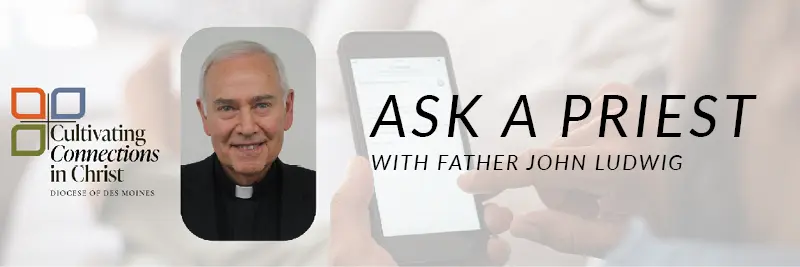Questions on Confirmation, Scripture readings, and what a "pall" is
by Father John Ludwig | September 20, 2024

Q. Our family moved here from a different diocese. That diocese celebrated the sacrament of confirmation in seventh or eighth grade. I’ve been told that now we celebrate confirmation in 10th grade. Can you help me understand this? - J.L., West Des Moines
You’re not the only one confused about this. When the sacrament of confirmation was revised following the Second Vatican Council, the ordinary age for confirmation was left up to the various national conferences of bishops. The United States Conference of Catholic Bishops left this choice of age to the local bishop. So, in the United States, there are many variations. A case can be made for combining the celebration of confirmation with baptism. This is frequently done when an adult is baptized or welcomed into the Church. And the ordinary minister in this case is not the bishop but rather the priest who is administering baptism. Another case would be to combine confirmation to First Communion. A few dioceses have made this choice. The remaining dioceses have chosen to celebrate confirmation with the faithful of diverse ages. In the Diocese of Des Moines presently, confirmation is conferred primarily in 10th grade.
Q. In a previous column, you noted that the Scripture readings for Sunday Mass are chosen in a certain way. Could you remind me how they are selected? - S.O., Norwalk
Sure. The book of readings is called the lectionary. Each year, beginning with the First Sunday of Advent, we begin a new liturgical year. The readings are chosen from the first three Gospels: Matthew (year A), Mark (year B), and Luke (year C). The Church uses a three-year cycle, which is repeated every three years. So, last November we began the Gospel of Mark (year B). This year, we’ll begin the Gospel of Luke (year C). And the following year, we’ll begin the Gospel of Matthew (year A). Ah, you say, the three Gospels – what about the Gospel of John? Well John’s Gospel is sprinkled through the three-year cycle, especially during the year when Mark’s Gospel is featured. Mark’s is the shortest Gospel, and so John’s Gospel is used more prominently during that year.
The first reading is from the Old Testament (except during the Easter season when the Acts of the Apostles is read). It is chosen to match the theme of the gospel for a given Sunday. The second reading is usually a consecutive reading of one of the epistles over several Sundays. These readings are read not only in Catholic churches, but also in other mainline Christian churches. Following the Second Vatican Council, this set of readings (or lectionary) was compiled to give the faithful a more comprehensive exposure to the Scriptures than was previously the case.
Q. Can you tell me what a pall is?
There are two types of palls used in the liturgy. One of them is the cloth that is placed over the coffin of the deceased at the funeral Mass. It’s white or off-white. The pall is reminiscent of the baptismal garment used following the immersion or pouring of water on the candidate.
A second kind of pall, not related as far as I can tell, is the square white cover for the chalice during the Mass. The practical purpose of this pall is to keep the wine before and after consecration free of any debris or flying insects. In older churches in previous centuries, this pall was more of a necessity for that purpose than it is in today’s churches.